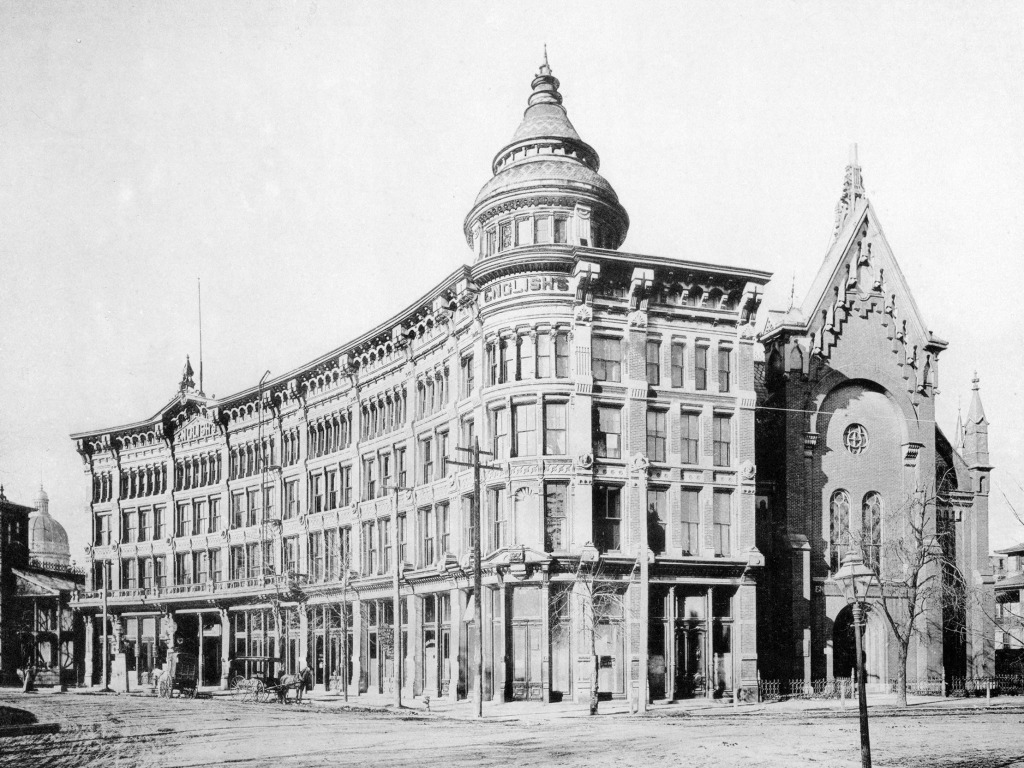Subscriber Benefit
As a subscriber you can listen to articles at work, in the car, or while you work out. Subscribe NowWith a belief that older structures give a city its personality, James Glass spent the past four years investigating a century’s worth of Indianapolis traits.
Glass, an architectural historian and historic preservation consultant, presents his findings in a two-volume set titled ”Architecture in Indianapolis, 1820-1920.” Indiana University Press published the first book, which spans 1820 to 1900, on Monday. The second book, focused on the first two decades of the 20th century, is scheduled for publication in 2025.
Parts of the city’s personality were demolished long ago. In the newly published book, Glass makes note of when significant buildings were razed, and why.
The northwest quadrant of Monument Circle, for instance, once was occupied by English’s Opera House and Hotel. The curved building’s four-story facade featured limestone pillars and an exterior balcony.
“When it was completed in 1897, it really provided a Parisian kind of air for the Circle,” Glass said. “It was a vision of urbanity or what the Circle could become.”
By 1948, the opera house and hotel were demolished to make way for a J.C. Penney Co. department store.
“If you think about where the mentality of everyone was back in 1948, it was, ‘All the old stuff needs to come down. It’s obsolete and can’t be used for anything. We want new, modern stuff to replace it,’” Glass said. “That was the vision at that time. People calculated the usefulness of a building by how old it was. By that measure, English’s Opera House and Hotel was old.”
In terms of what the city has maintained since the 19th century, the center of Monument Circle has a crown jewel in the Soldiers and Sailors Monument.
Glass writes that the Indiana legislature appropriated $200,000 in 1887 to place a monument on the site of Circle Park (originally occupied by a governor’s house devised by city planner Alexander Ralston in 1821).
The 284-foot tribute to Civil War combatants was designed by German architect Bruno Schmitz.
“The Soldiers and Sailors Monument is a major work of civic art,” Glass said. “It’s certainly a symbol of the city. It’s also the largest, most elaborate memorial to Union veterans in the whole country.”
The modern Circle also is home to Christ Episcopal Church, designed by Irish-born architect William Tinsley and built in 1857. Glass credits a towering Indianapolis philanthropist for the structure’s longevity.
“They had a wood-frame church in the late 1830s, but they outgrew that in only 20 years and built the impressive Gothic rubble limestone church,” Glass said. “At one point there were five churches on the Circle. This is the only one of those left. I think Mr. Eli Lilly can take credit for that. He was devoted to that church and helped it financially at a key point.”
Luck plays a role in historic preservation, Glass said, and the city’s first significant architect was in the right place at the right time. John Elder wasn’t formally trained as an architect, but he thrived during a “canal boom” that spurred growth in Indianapolis during the late 1830s.
Glass writes about Elder’s work on hotels, residences, churches, bank buildings, a hospital wing and a school for the blind.
“He was resourceful enough to be able to juggle all responsibilities of an architect or builder at that time,” Glass said. “You had to find clients. You had to make drawings or find a design they liked. You had to link up with a contractor, which he did with a man named Ephraim Colestock, and then get the building built to the client’s satisfaction.”
None of Elder’s buildings exist today. Glass said the oldest structure in the city is the Sanders-Childers House, a brick farmhouse built in the 1820s. In 1987, Indiana Landmarks spearheaded renovations at the house on East Palmer Street between Fountain Square and Garfield Park.
Glass, who filled more than 600 pages for each volume of “Architecture in Indianapolis,” will sign copies of the first book and present an illustrated lecture titled “Italianate and Second Empire in Indianapolis” on Nov. 7 at the Indiana Landmarks Center, 1201 Central Ave.
‘Italianate and Second Empire in Indianapolis’
- What: An illustrated lecture on Indianapolis architecture in the mid-19th century by James Glass
- When: 6 p.m. Nov. 7
- Where: Indiana Landmarks Center, 1201 Central Ave.
- Tickets: $10, or free for Indiana Landmarks members
- Info: Visit indianalandmarks.org.
Please enable JavaScript to view this content.


I’m looking forward to diving into the book/s!